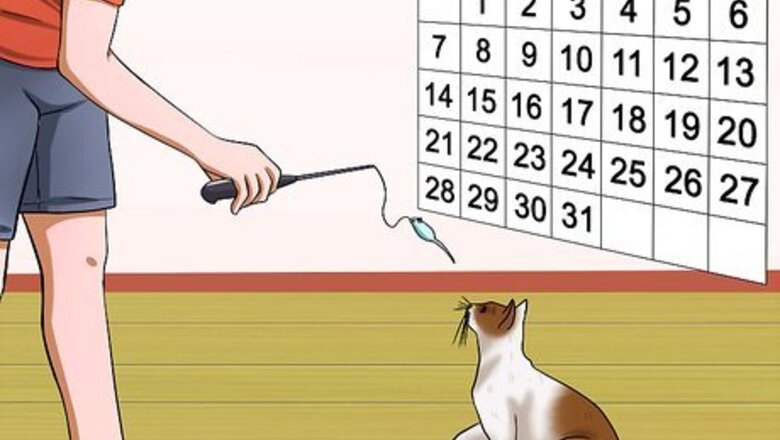
views
X
Research source
If not stopped, this kind of behavior can pose a real danger to you.[2]
X
Trustworthy Source
American Society for the Prevention of Cruelty to Animals
Leading organization dedicated to the prevention of animal cruelty
Go to source
Knowing why your cat is attacking you and what you can do to stop her from doing this will help improve your relationship and interactions with your cat.
Stopping Your Cat From Attacking You
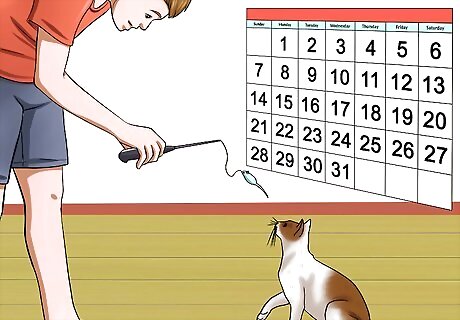
Schedule daily, interactive play sessions with your cat. The sessions should last about 10 minutes each and take place when your cat is in a playful mood. Try to schedule at least two of these sessions a day. Increasing the amount of time that you play with her will address one of the possible causes of her attacks, and can serve as an opportunity to teach her not to attack and/or bite you. A pole-type toy or a toy that dangles, both of which can be homemade or purchased at your local pet store, will keep distance between your cat and your hands and feet. This type of toy also fosters her natural predator-prey instinct. Stuffed animal toys are helpful if your cat likes to wrestle; they are especially helpful for kittens. Select a stuffed animal toy that is about the size of your cat. If she’s getting too rough with you during playtime, rub the stuffed animal against her belly to redirect her play from you to the stuffed animal. You can also throw one of her favorite toys away from you during playtime. Throwing the toy will serve two purposes–you are keeping her away from your hands and feet, and you are fostering her natural instinct to chase and pounce.
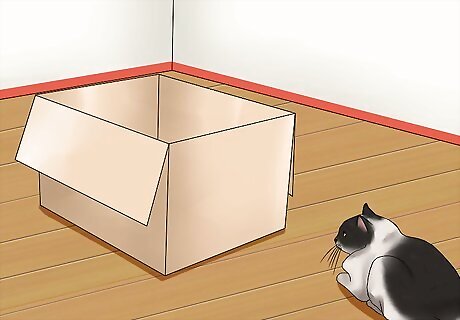
Provide her with more environmental stimulation. If you can keep your cat busy in her environment, she will probably spend less time trying to attack you. One way to increase this stimulation is to have a variety of toys and rotate them out on a regular basis. It is not necessary to buy new toys on a consistent basis. You can just put out the ones you have in different combinations so that she is not always playing with the same set of toys. Regularly give your cat new things to explore, such as an empty cardboard box. Provide your cat with puzzle feeders. Puzzle feeders are toys in which you can place food. Your cat will need to put in extra effort to get the food, which will keep her busy and mentally stimulated. Place an old toy in something new, such as an empty cardboard box or paper bag. This is helpful if you notice that your cat has gotten bored with some of her older toys. Place climbing perches or scratching posts in your cat’s favorite spots to give her something to climb and play on. Cats tend to feel safer when they're up higher. If your cat is comfortable with being outside, you could purchase or build an outdoor enclosure so that she can safely play outside. Visit your local pet store to learn about the different types of outdoor enclosures that are available.

Give your cat a time-out if she plays too roughly. Get up and walk out of the room, without paying her any attention, if her playing becomes too rough. You can even go so far as walking to another room and closing the door, blocking her access to you. Because cats avoid doing things that have a negative result, taking the fun of out playtime will teach her not to play roughly with you. It is important that you walk away from her, rather than pick her up and move her to a different room. Your cat could interpret your physical touch as a reward, and you do not want to reward her for rough play.
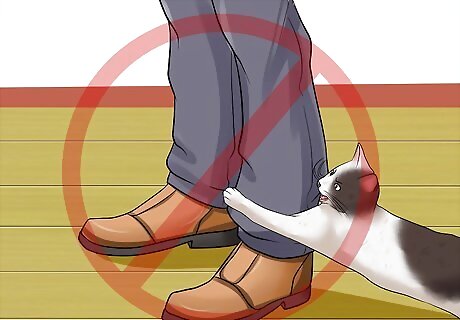
Prevent her from attacking your ankle. When you least expect it, your cat may jump out and start biting your ankle. To your cat, your ankle is an easy moving target, especially if she does not have many other toys or objects in her environment to keep her busy. When she bites your ankle, do not try to run or pull away. Running or pulling away resembles prey behavior, and your cat’s predatory instincts will encourage her to just bite down harder. Instead of trying to get away, gently push toward her. Because prey tend not to move toward the predator, you will confuse your cat with this action. She will let go of your ankle when she realizes that you’re not acting like prey. When she lets go, stay still for a moment and don’t pay her any attention. She will stop biting your ankle when you take away the thrill of the catch.
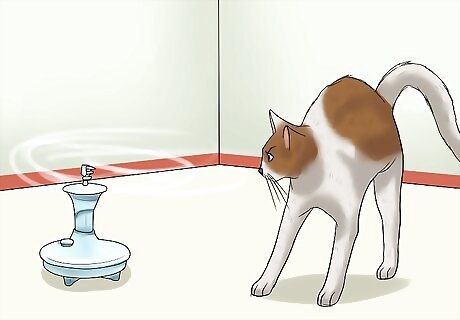
Set up deterrent devices in her usual stalking spots. If you have identified areas where your cat likes to hide and try to attack you, make those areas as undesirable to her as you can. There are commercially-available deterrent devices that you can use, such as upside-down mousetraps and motion-activated devices that spray compressed air. These devices will startle your cat without injuring her. Eventually, she will stop returning those areas because of the startling effect and noise of those devices. The upside-down mousetrap will flip into the air when your cat steps on it.
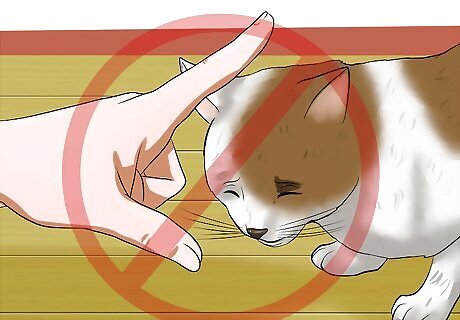
Do not punish your cat. It is very important to remember that cats do not learn by punishment (eg, yelling, hitting, tapping her on the nose). Rather, your cat will become fearful and wary of you if you punish her. She may even become confused. Because the punishment would likely come after whatever she did wrong, she would not really know what she’s being punished for. Some cats may even see the punishment as a challenge, rather than as a deterrent.
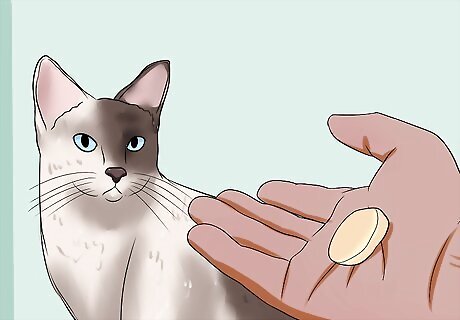
Reward her for good behavior. Cats will repeat behavior that has positive consequences. If you give her plenty of positive reinforcement when she does the right thing (eg, playing gently with you, snuggling with you instead of biting your hands), she will continue to do it. Keep in mind that you need to give her the positive reinforcement during her good behavior so that she will form an association between good behavior and reward.
Learning About Cat Attacks
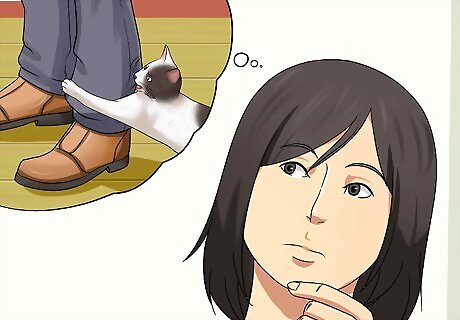
Learn why your cat is attacking you. In the wild, cats are predators. When your cat is stalking you and attacking and/or biting you, she is seeing you as prey. You probably don’t see yourself as prey, since you, her owner, are bigger than she is. However, even if your cat attacks nothing more than your ankles, she is demonstrating her natural predator instincts. Your cat may also be attacking you because she does not have enough toys or other environmental stimulation to keep her busy. She might be bored, and sees you as an easy target. An insufficient amount of interactive playtime can also cause her to attack. Kittens that are separated too early from their mother and littermates do not learn how to stop biting, so they are more prone to attacking and biting you as her owner. What you might see as cute behavior in a kitten can actually become a very problematic behavioral issue. Medical issues, such as hyperthyroidism and central nervous system dysfunction, may also be causing the attacks. Your veterinarian can determine if medical issues are the root cause. Medical issues should be ruled out first before considering behavioral issues.

Observe your cat’s body language. When you are playing with your cat, it may not be easy to tell the difference between normal play behavior and attack behavior (playing too roughly). Your cat will give you subtle clues to let you know whether her intentions are playful or harmful. For example, if she is in a bright and playful mood, she will open her mouth halfway, pounce or hop sideways, and have an arched back; she likely won’t make much noise. When she is approaching attack mode, she will start hissing, growling, or spitting during playtime. She may also start trying to grab your hand to bite it. You may see her ears flatten, pupils dilate, and tail swish back and forth. If you are not playing with her, but notice that she is stalking you, you can be fairly confident that she’s about to try to attack you.
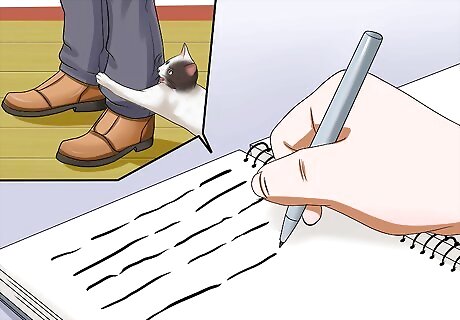
Keep a record of her attacks. Keeping a record of when your cat attacks you can help you get a better understanding of the situations and times when she is most likely to attack. For example, you may notice that she tends to bite your ankles in the morning to wake you up, or becomes aggressive each time that you play and interact with her. If you are able to anticipate when she is most likely to attack, you can do some pre-planning to try to redirect her attention from attacking you to maybe playing with a toy.


















Comments
0 comment